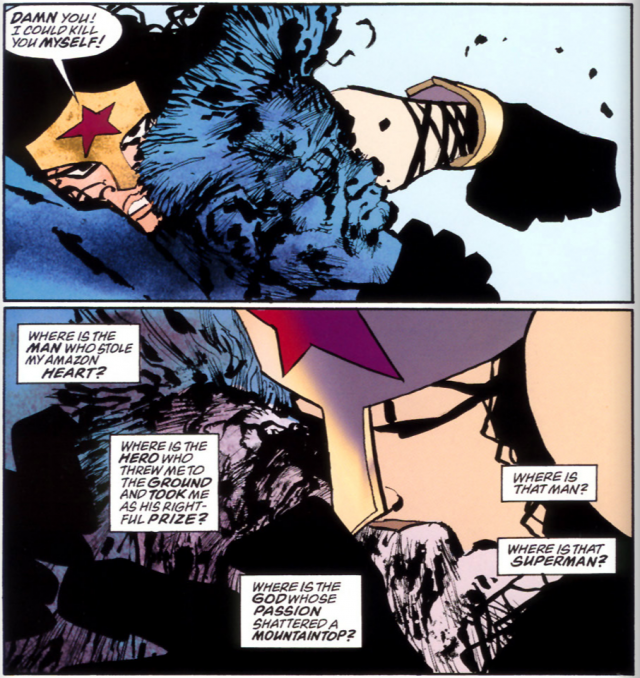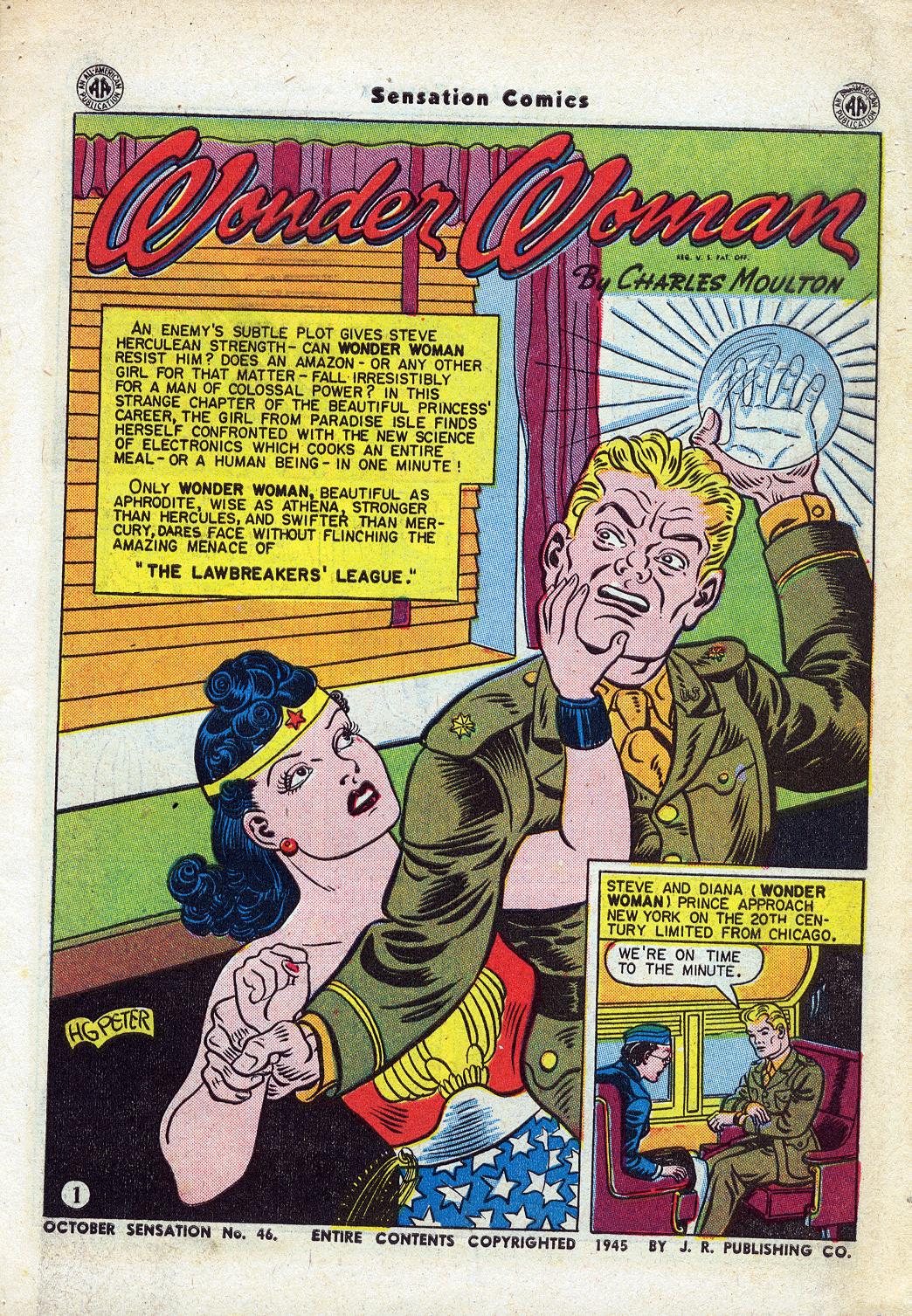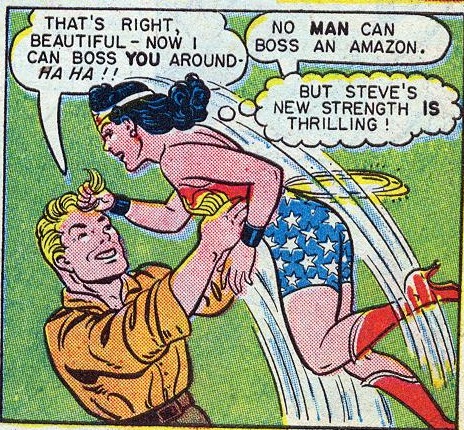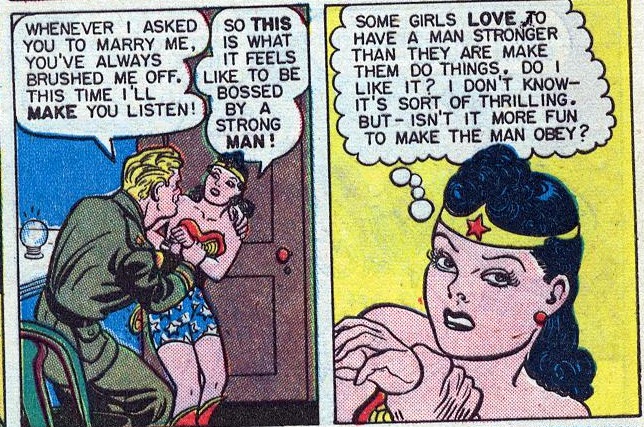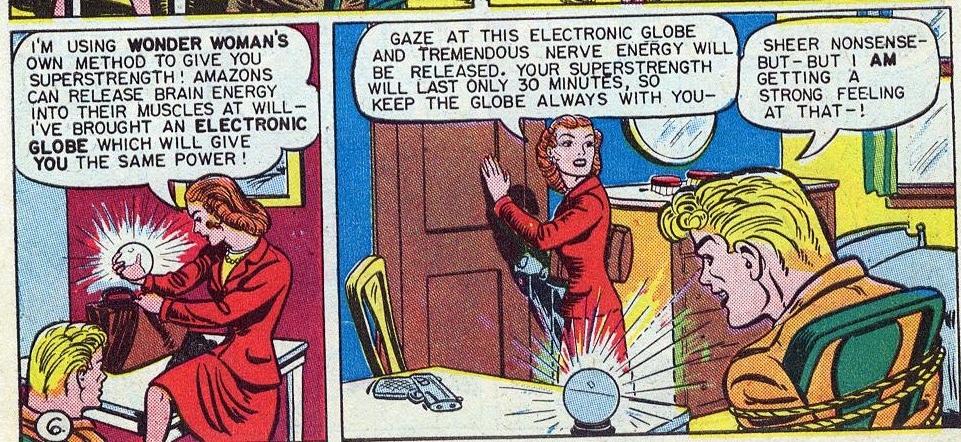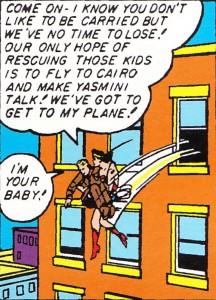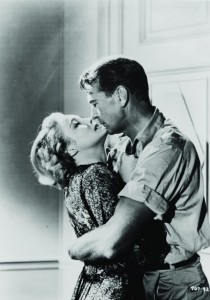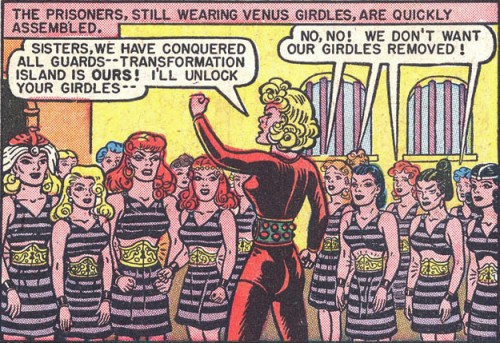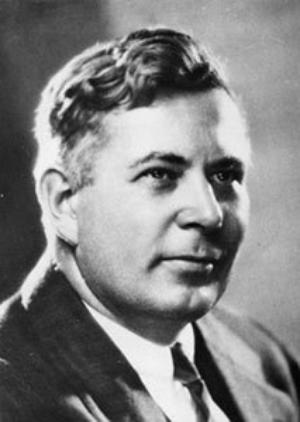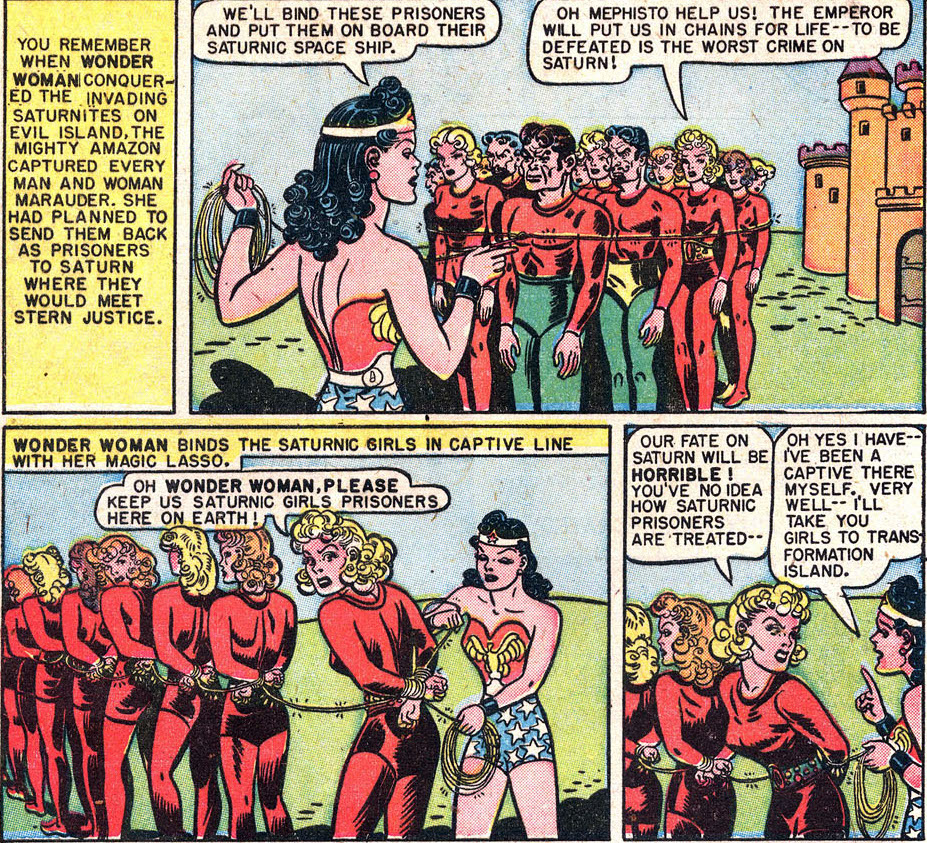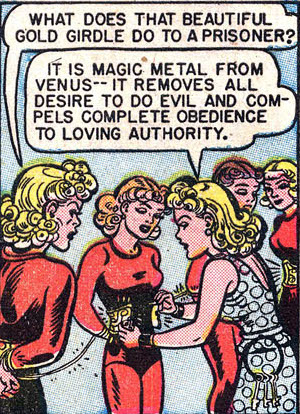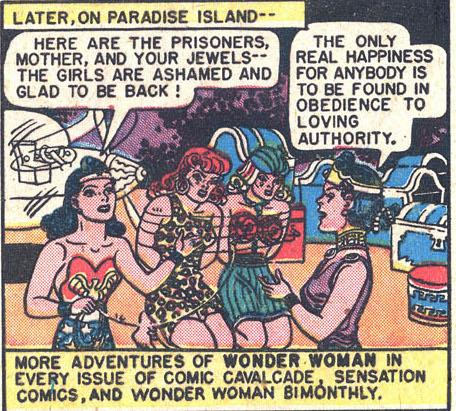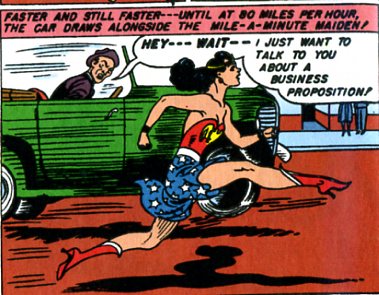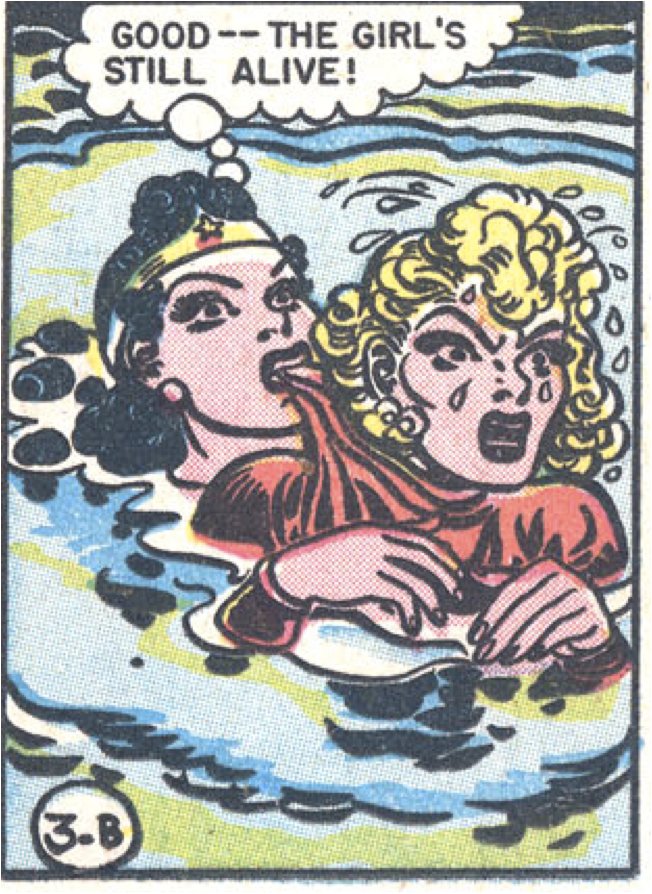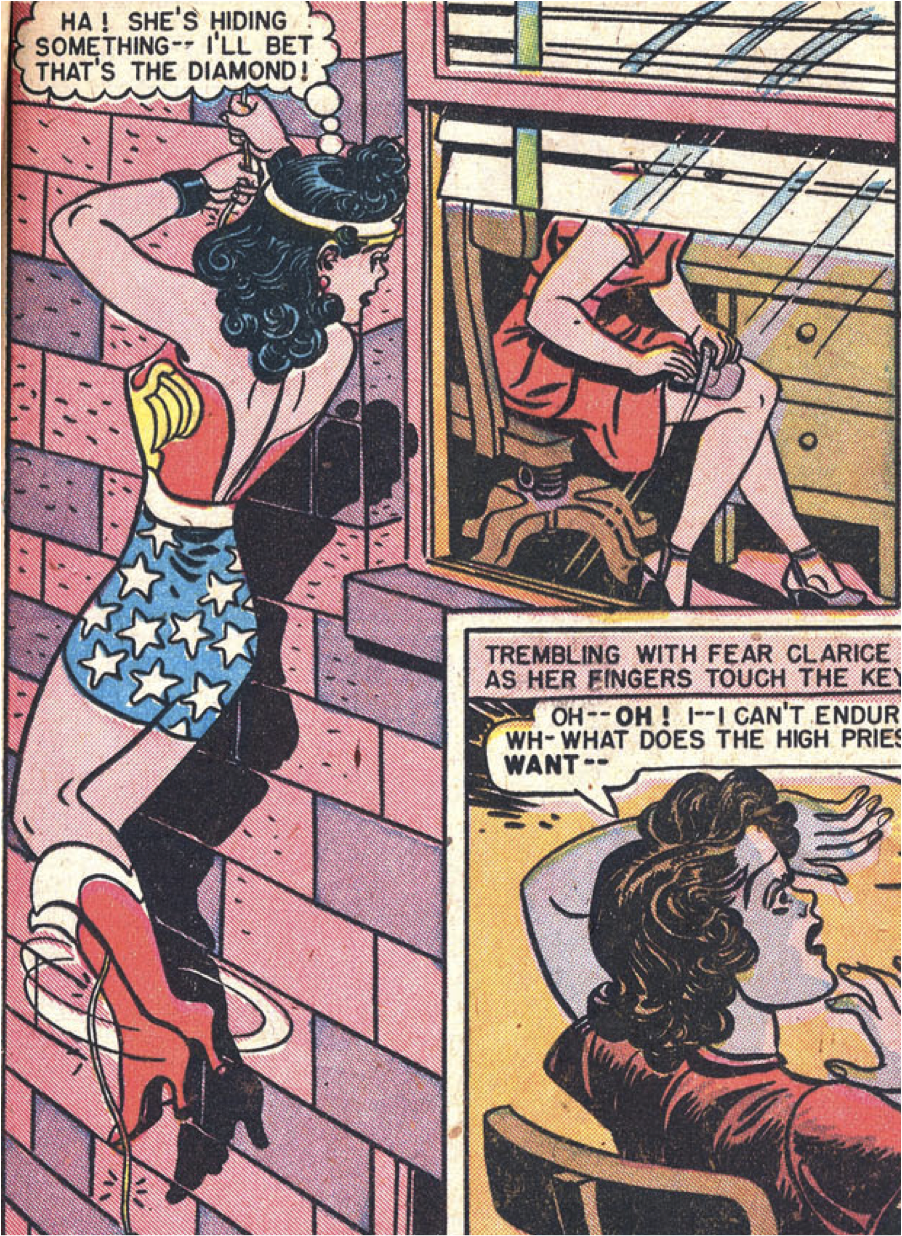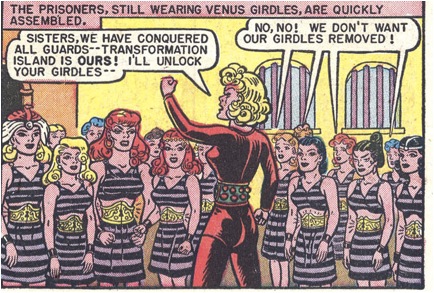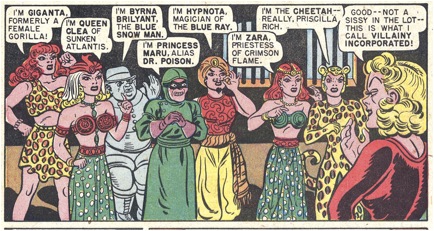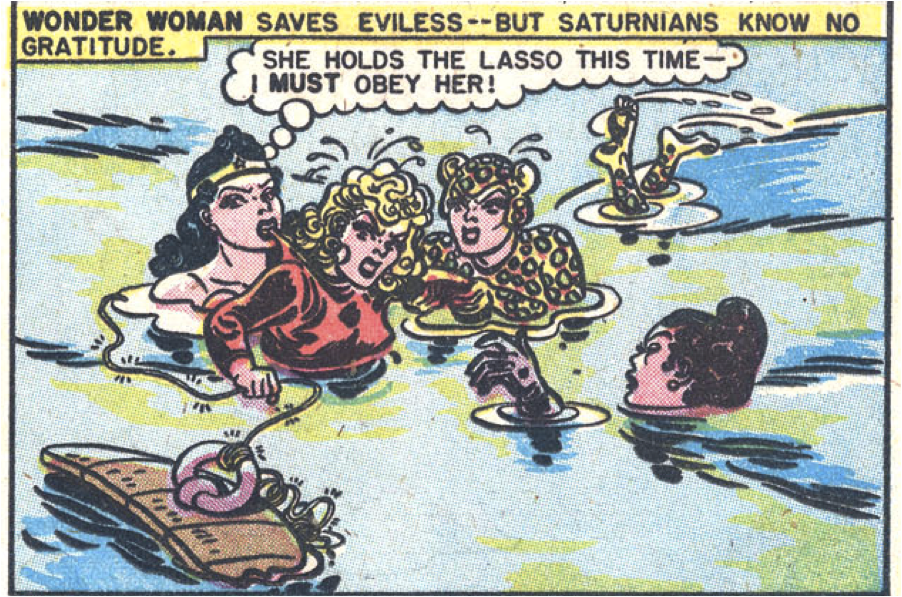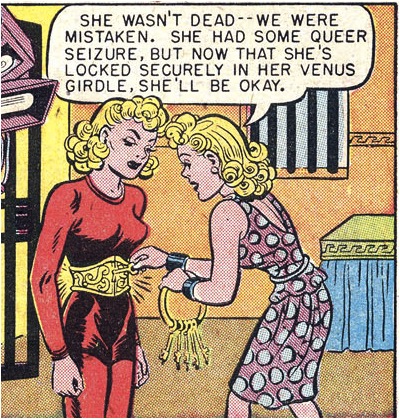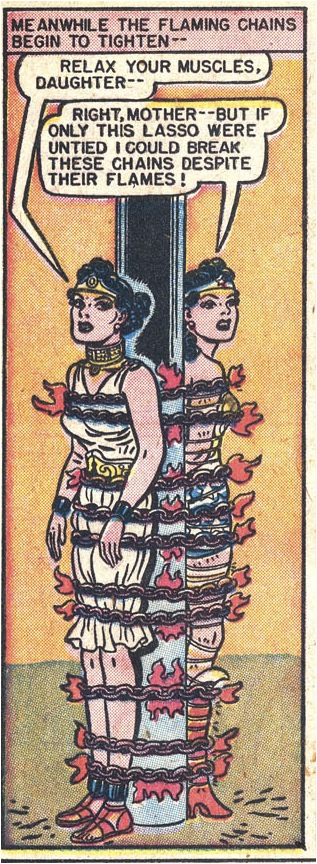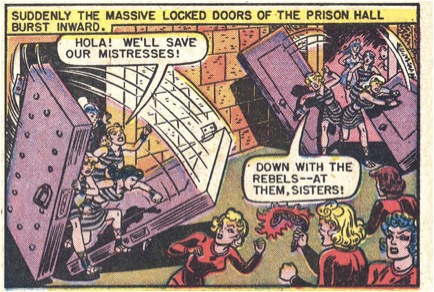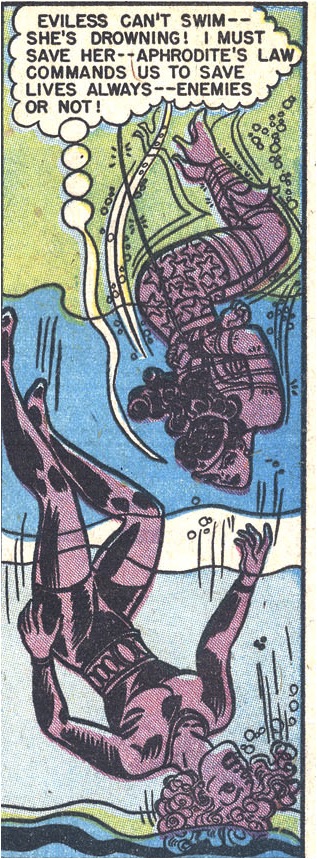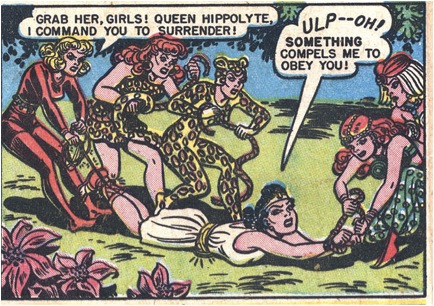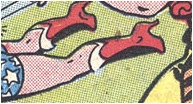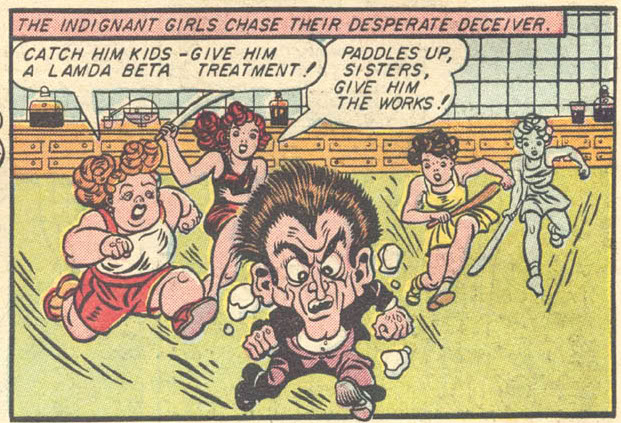This is part of a roundtable on Wonder Woman #28.
__________________________________
So there’s this warrior princess, right? Think of her as Xena avant la lettre, only with more lesbian subtext. Although, actually, it’s more than subtext; hell, it’s more than text-text. Anyway, she’s a warrior princess from a hidden island of Amazons, sent out into the world during WWII to teach men and women the joys of loving-submission, spanking and being spanked, playing with ropes, and dressing up in a deer costume that gives me funny feelings in my underpants.
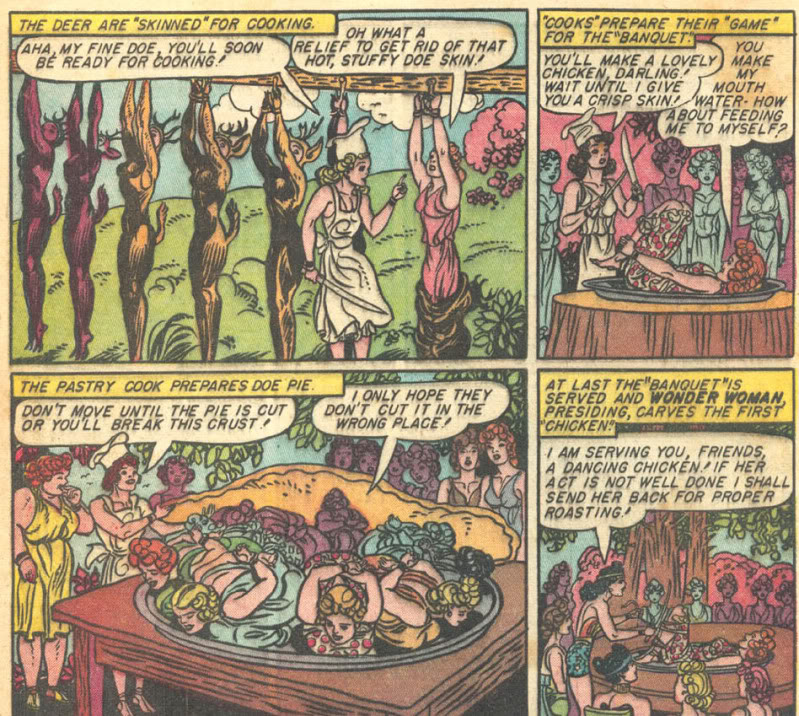
No, wait, she’s just an ordinary superhero and member of the Justice Society of America, even though she’s just a secretary, and not even a glorified secretary.
No, wait, she doesn’t have any powers and dresses suspiciously somewhat exactly like Emma Peel.
No, wait, she has powers again and has to rejoin the boys’ club.
No, wait, she’s reduced to primordial protoplasm and reborn from clay. Then back to being an ambassador for peace from the island of Amazons.
No, wait, she’s a total hard-case warrior, willing to make the hard decisions to do whatever hard things need to be done by hard men and hard women in a hard world full of hardness.
No, wait, she’s being written by a grown-up actual novelist who’s written, like, real books (!) for grown-ups (!!) and is a chick, besides (!!!).
No, wait, in a shocking twist that will reshape the very foundations of the DC universe for years to come she — you’d better be sitting down for this one — wears pants.
AND — stand up again, so you can sit back down — also a jacket.
No, wait, she who the fuck gives a shit?
***
Pretend for a moment that you could make it through something like this wikipedia entry on Wonder Woman without your eyes rolling back into your skull and your brains dribbling out your ears. If you could do this, you’d quickly realise that Wonder Woman, from all the available evidence, has been in constant need of ‘fixing’ pretty much from the moment that her creators keeled over and stopped working on her — first William Moulton Marston and, eleven years later, H.G. Peter.
Indeed, here’s some pseudo-research I’ve done through Google, when I wasn’t busy searching for crossover fanfic between Twilight and A la Recherche (Team Swann!) or working on my 1100-page spec script for Etta Candy: Year One.
Search for “Wonder Woman”: 27,700,000 results
Superman: 179,000,000
Batman -Arkham*: 1,970,000,000
Okay, so Batman >> Superman >> Wonder Woman. Now try adding the phrase “how to fix” to each of these, and we get:
“how to fix Wonder Woman”: 15,000
“how to fix Superman“: 4,150
“how to fix Batman” -Arkham*: 2,220
[without the extra restriction, the Batman search produces thousands of results about how to fix bugs in a particular series of video games, rather than how to fix the character]
So there are approximately one zillion fewer pages about Wonder Woman than about Batman, but there are seven times as many pages about how to fix her. The internet has spoken: Wonder Woman needs fixing. Luckily there are 15,000 budding writers (sic), comics critics (double-sic), comics historians (triple-sic) and other comics researchers (infinity-tuple sic) who know exactly what she needs in order to be fixed.
***
All right, so everybody and his dog thinks Wonder Woman needs fixing. But why does Wonder Woman “need” fixing?
The obvious answer is twofold: first, the character is a valuable “intellectual property” with a high “Q rating” which can be transformed into desirable “branding” for various consumer items such as little girls’ underwear
HELLO GOOGLERS WELCOME TO THE PRONOGRAPHY
and thereby turned into oblations and offertories for our benevolent corporate overlords.
Second, the people who make superhero comics in America couldn’t sell crack to crackheads, so you can imagine how they struggle selling [obligatory joke: superhero comics suck] to [obligatory joke: fanboys suck].
The result is that, every few weeks, someone at DC-HQ realises that they could replace all the toilet paper in the building with rolls of hundred dollar bills, and it would still be more profitable than trying to sell Wonder Woman comics. So, every few weeks, it’s a Bold! New! Direction! in an ever more desperate attempt to boost her sales to a level befitting the distaff member of the “DC Trinity” (double-infinity-tuple sic). And, every few weeks, sales still suck, and it’s time for another Bold! New! Direction! You can see the flop-sweat on every page.
***
The thing is, this is not an isolated case of DC not knowing what to do with one of their “iconic” characters — i.e. characters that are underwearable because they were once on a TV show. Consider the case of Captain Marvel, created by C.C. Beck, Bill Parker and Otto Binder.
Phenomenally successful in the 1940s, the character — then published by Fawcett — was essentially sued out of the business by DC in the ’50s. Twenty years later, in a move showing all the class we associate with the North American comic book industry, DC actually licensed the rights for Captain Marvel — the character they had sued out of business — from Fawcett — the business they had sued him out of. As the Bard said, that’s
like making a soldier drop his weapon,
shooting him, and telling him to get to steppin’.
Obviously, they came to portion of his fortune
Sounds to me like that old robbery-extortion.
Which, come to think of it, describes the entire business-model of DC (and Marvel).
Anyway, DC’s 1970s revival of the character stayed fairly faithful to the original but fizzled out soon enough. He hung around as a back-up feature until the 1985 Crisis on Infinite Earths, and if you don’t know what that is, consider yourself lucky and leave it at that. In the wake of Crisis, DC revamped most of its “intellectual properties” including Captain Marvel. In his new origin, his arch-nemesis Dr Sivana became his abusive uncle. This revamp stuck for only a few years, until journeyman writer/artist Jerry Ordway rerevamped the Big Red Cheese back closer to the original.
This version lasted for another fifteen years or so, until 2005, when DC kills off the kindly wizard Shazam (who gave Marvel his powers). Marvel takes on the role of Shazam and promptly turns into a schizophrenic — literally, he goes nuts and hears voices. Shortly afterwards, his wholesome gal analogue Marvel Marvel gets turned into a Bad Girl. More boring, unreadable shit happens, Marvel loses his powers, then DC rerererererererevamps its comics and there’s no Marvel again for a little while…until now.
The updated Captain Marvel for a whole new generation is to be called Shazam, have a darker origin prominently involving, I don’t know, the war on drugs or something, and wear a hat made from the skins of dead orphans and hookers.
He probably also has a tattoo of some kind.
…
TO THE MAX.
***
Any sane person would look at this weak-ass publishing history and ask herself a couple of questions: Why haven’t there been any decent Wonder Woman comics since the originals? Ditto for Captain Marvel? Ditto for the Spirit; ditto for Plastic Man? Why can’t DC sell comics starring these characters? What’s a Grecian urn? And why is my cat sending me telepathic warnings that “the Jews” are out to get me?
Uh, maybe that last one is just me. But, any sane person, you otherwise ask some good questions. Why do all the other Wonder Woman comics suck? And — since severe suckitude is not now, and has never been, an impediment to popular success — why don’t those comics sell, when (by contrast) DC could print a hundred issues of Batman watching the Batgrass grow, one blade at a time, and still make a mint?
There are, I submit, three main reasons.
1) Pure goddamn chance.
When we try to explain history of any kind, in art or anywhere else, it’s way too easy to spin out elaborate just-so rationales, and overlook the importance of sheer luck. But, pace Grant Morrison, there’s not some ineluctable cosmic law that the World Spirit will lead to, e.g., Superman’s enduring status as an icon, or Batman’s. On the contrary, a lot of that status is due to one lucky break after another. Had things gone slightly differently, there might never have been a popular TV series in the sixties about Batman, and the character might have faded into the same general obscurity as Barney Google, Li’l Abner or Herbie the Fat Fury.
Hell, there could have been a popular TV series about Lil’ Abner instead, and decades later we’d all be praising Heath Ledger’s cross-dressing performance as Sadie Hawkins.
“Christopher Nolan has given the comic strip movie some much-needed gravitas by returning Li’l Abner to his grim and gritty roots as a violent, pig-fucking hillbilly…”
So, to some extent, the failures artistic and financial of Wonder Woman comics post-Marston/Peter really are just accidents of history. They don’t sell for a bunch of different random reasons, and they aren’t any good because…well, to some extent because no one of the caliber of Marston or Peter has given it a shot. I mean, look at the list of people who’ve worked on the comic after them; we’re not talking Kurtzman or Giraud here.
Ditto for Captain Marvel, ditto Plastic Man, ditto your mom.
2) The original comics are fun and whimsical
But since it’s easy to spin out elaborate just-so rationales, here’s one I prepared earlier. The obvious feature that Wonder Woman has in common with Plastic Man and Captain Marvel is that they’re all light-hearted. Certainly, Wonder Woman has a heavy intellectual foundation in Marston’s crackpot unconventional theories about men, women and bondage — and I’m not 100% sure about this, but I have a crazy hunch that Marston’s theories might be discussed elsewhere in the roundtable — but it’s all covered with a giant bouncing castle and fairground. Certainly in all of these comics what’s above the surface is thoroughly unserious — and, for a boring set of boring reasons that it’s too boring to go into here, “fun” superheroes are an exceedingly hard sell in today’s Direct Market. This has got to be part of the explanation for why DC can’t sell comics which return to the original spirit of these characters.
3) The original comics are good
…And here’s another just-so story. There’s an uncomfortable truth about superhero comics from the 30s and 40s, a truth that’s not generally acknowledged but is thuddingly apparent as soon as you start reading most of them: 90% of those comics are complete shit.
I don’t want to be a troll here, and just baldly make some sweeping aesthetic judgement for which I provide no evidence other than my suave and confident manner. The Hooded Utilitarian is no place for that kind of thing. But seriously, people. Seriously. Try reading five pages of almost any superhero comic from those times. Just try it. I guarantee that, by the time you get to page three, you’ll wish you had a time machine so you could go back to the past and make sure you never started reading it, if need be by shooting yourself in the face.
Superman is shit. Batman is shit. Green Lantern is shit. The Human Torch is shit. Ka-Zar is shit. The Seven Soldiers of Victory is shit. The Angel is shit. The Justice Society of America is shit. The Claw is shit. Daredevil is shit. Sandman is shit. The Newsboy Legion is shit. Captain America is shit. (Sorry, Kirby fans, but it’s true)
Apologists try to gloss over this with a range of euphemisms. These comics are “lively”, “boisterous”, “crudely energetic”, “charming”, “rough and tumble”. Behold the soft bigotry of low expectations. To euphemize thus is to insult the genuine comic artistry that you could find in the funny pages at that time, or the decades beforehand. The 30s and 40s, after all, were a genuine golden age for comic strips; even if we limit ourselves to adventure continuities, there’s Terry and the Pirates followed by Steve Canyon, Thimble Theatre, Prince Valiant, Wash Tubbs and Captain Easy followed by Buz Sawyer, Mickey Mouse, Alley Oop, Dick Tracy, Li’l Abner, The Spirit and probably others that I’m forgetting. Show me a single page from Action or Detective Comics that is equal to anything in any of those strips and I’ll eat my words. Hell, I’ll eat every single word in this goddamn post.
No, 90% of those superhero comics were poorly written and, though it hardly seems possible, even worse drawn.
But there were 10% that were okay to good, sometimes even great. Wonder Woman was one of them. So were Captain Marvel and associated strips; so was Plastic Man; so was Sub-Mariner, at least intermittently; so were Fantomah and Stardust. I don’t know their work well enough to comment, but I’d imagine Meskin, Fine, Wolverton and Powell also did some good work in the genre. Probably a few others. But that’s pretty slim pickings for a so-called Golden Age.
So, Wonder Woman was an island of above-average art in a sea of mediocrity, so what? Why should that mean that almost every later Wonder Woman comic is not very good? Two reasons: regression to the mean, and what I call the BOOS hypothesis.
Regression to the mean is a simple mathematical fact about any set of things that contains variation — comics, bananas, comics about bananas… If you pick one of these items at random and it’s at the extreme in some value or other, the next item you pick at random is likely to be closer to the average. If you’ve got 100 bananas and you pick out the fifth biggest banana, the next one you pick is probably going to be smaller.
Similarly with comics. The Wonder Woman comics produced by her creators were well above the average superhero comic; therefore it’s highly probably that most other Wonder Woman comics are going to be worse.
But regression to the mean can’t be the whole story, because that only explains why subsequent Wonder Woman comics haven’t been as good as Marston/Peter. It doesn’t explain why they generally haven’t been good full-stop.
Which is where I offer — verrrry tentatively — the Benefit Of Original Shittiness hypothesis, or BOOS. BOOS is a hypothesis about comics that (a) were financial successes fairly early on and (b) have since been written/drawn by artists other than their creators. We’re basically talking corporate-owned “properties” like Wonder Woman, Archie, et al., or syndicated comic strips like Gasoline Alley or Garfield.
BOOS, then, claims that the shittier these original comics were, the more likely it is that later versions by other artists will be good. Why have there been good Batman and Superman stories decades after Bill Finger “and Bob Kane”, and Jerry Siegel and Joe Shuster, in spite of the fact that those original comics are pretty lousy? Why have there been so few good Wonder Woman stories in spite of the fact that the originals are so good? BOOS inverts the logic of those questions: it’s because the original Superman and Batman comics suck that later ones are good; and it’s because the original Wonder Woman comics don’t suck that later ones do.
My thought here — and, as I say, I offer it very tentatively — is that it’s no coincidence that the better superhero comics from the 30s and 40s have had generally shitty afterlives with later artists, but that the most influential and long-lasting comics — viz. Batman and Superman — had shitty beginnings. Whatever it was that made Batman and Superman popular, it was absolutely, utterly, definitely, assuredly, etceterally in no way whatsoever the artistic or narrative skills of their creators. Those guys couldn’t write or draw for shit. (None of this is to deny that DC treated them disgracefully). And that means that later artists working with the same materials can do even better.
By contrast, the original Wonder Woman comics were popular because Marston and Peter were genuinely talented. And that’s a lot harder for later artists to replicate.
Is this all just an extraordinarily long-winded way of saying that Superman and Batman are just stronger concepts or better characters than Wonder Woman? Maybe — but whatever made the original Superman and Batman comics popular need not have been the intrinsic superiority of the concepts. It could have been that they tweaked a certain demographic a certain way, and that demographic still likes to be tweaked in that certain special way even today, you know what I’m talking about
HELLO GOOGLERS
but Wonder Woman doesn’t do that kind of tweaking any more.
But even if we ultimately accept that Superman and Batman are “intrinsically better”, the logic by which we got there was very different from the way “comics scholars” normally do. They usually get there by arguing either (a) the concepts “alien in underpants as milquetoast daydream” and “playboy fetishist beats up poor people” are obviously better than “empowered warrior princess” QED, or (b) the concepts are obviously better because they’ve been more financially and critically successful over the years.
By contrast, I’m arguing that, if BOOS is right, Wonder Woman may not be as “strong” a concept, but it’s not because she can’t sell books, or support great art post-Marston/Peter. I’m arguing that Wonder Woman isn’t as “strong” a concept because the original Superman and Batman comics suck.
***
In conclusion: how do you solve a problem like Diana?
I’m thinking…a jacket — with shoulder-pads.

